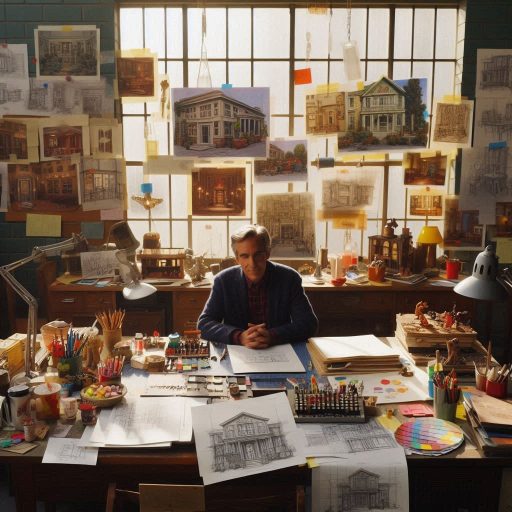Introduction
Film and TV production design is a key element in visual storytelling, as it brings scripts to life by creating the worlds in which stories take place as Film and TV Production Design Books.
From the layout of sets to the selection of props and costumes, production design shapes the atmosphere, mood, and tone of a project.
A well-designed set can enhance a scene, making it more immersive and emotionally engaging for the audience.
Without strong production design, even the best story can fall flat visually.
For aspiring production designers, books are a valuable resource for learning the fundamentals of the craft.
They offer in-depth insights into the history of production design, as well as practical techniques that help designers create captivating environments.
Books also provide real-world case studies and examples that inspire creativity and problem-solving skills.
In this post, we will introduce some of the top books for aspiring production designers.
These books cover topics like the basics of set design, color theory, and the collaborative process with directors and other departments.
By reading these resources, you can develop a strong foundation in production design and gain a deeper understanding of how to create visually impactful work.
“Cinematic Storytelling: The 100 Most Powerful Film Conventions Every Filmmaker Must Know” by Jennifer Van Sijll
In this book, Jennifer Van Sijll explains essential concepts and techniques for filmmakers to create impactful visual storytelling.
The author breaks down the 100 most powerful film conventions that every filmmaker should be familiar with to effectively convey story and emotion through visuals.
Key Concepts and Techniques Covered
- Understanding the importance of visual storytelling in film
- Exploring various camera techniques and shot compositions
- Utilizing color theory and lighting to enhance mood and atmosphere
- Creating visual continuity and coherence within a film
- Emphasizing the significance of production design in conveying narrative
How This Book Benefits Aspiring Production Designers
This book offers aspiring production designers a comprehensive guide to mastering the foundational elements of visual storytelling in film.
Production designers can enhance storytelling by learning 100 powerful film conventions and applying them to their design choices.
These conventions help communicate the narrative and emotional aspects of a story more effectively.
By studying the key concepts and techniques covered in the book, aspiring production designers can:
- Gain a deeper insight into the role of production design in storytelling
- Learn how to use visual elements to enhance the overall film experience
- Understand the importance of collaboration with directors and cinematographers
- Develop a critical eye for evaluating and analyzing visual storytelling in films
- Expand their knowledge of industry-standard practices and conventions
“Cinematic Storytelling” provides aspiring production designers with a valuable resource to deepen their understanding of visual storytelling.
It helps them enhance their craft and elevate their skills in film production.
By mastering key concepts and techniques from the book, production designers can create compelling and immersive cinematic experiences using design elements.
Read: How to Create Memorable Characters: Pro Tips
“The Filmmaker’s Eye: Learning (and Breaking) the Rules of Cinematic Composition” by Gustavo Mercado
Gustavo Mercado’s “The Filmmaker’s Eye” is an invaluable resource for anyone involved in visual storytelling, including production designers.
The book examines the principles of cinematic composition.
It provides insights and practical examples that enhance understanding.
Readers learn how visual elements influence storytelling.
Mercado breaks down these principles to empower filmmakers.
This approach helps them master traditional composition techniques.
It also encourages them to creatively deviate from these techniques for artistic expression.
Highlighting Visual Composition Principles and Examples
Mercado outlines several key principles of visual composition that are essential for creating engaging and effective cinematic images:
Rule of Thirds
This classic principle divides the frame into a grid of nine equal sections.
By positioning subjects along the grid lines or at their intersections, filmmakers can create balance and interest in the composition.
Mercado illustrates this with examples from well-known films, demonstrating how directors use this rule to guide the viewer‘s eye and enhance storytelling.
Leading Lines
Leading lines are natural lines within the scene that direct the viewer’s gaze towards the subject.
Mercado provides examples of how filmmakers use roads, rivers, or architectural lines to lead the viewer‘s attention and create depth.
This technique can help production designers think critically about how to structure their sets and choose props that contribute to leading the eye.
Framing
Framing involves using elements within the scene to create a “frame” around the subject.
This could include doorways, windows, or overhanging branches.
Mercado highlights how effective framing can add context and depth, drawing the audience‘s focus to the subject.
Production designers can apply this principle by considering how set design and prop placement can frame key actions or characters.
Balance and Symmetry
Mercado discusses the importance of balance in composition, whether through symmetry or asymmetry.
Symmetrical compositions create a sense of order and stability, while asymmetrical compositions can generate tension or movement.
Examples from various films illustrate how balance affects audience perception.
Production designers can use these concepts to create visual harmony in their designs, enhancing the narrative impact.
Depth and Perspective
Creating a sense of depth in a two-dimensional frame is crucial for engaging visuals.
Mercado explains techniques such as overlapping elements, varying the size of objects, and using atmospheric perspective to add dimension.
This principle is particularly valuable for production designers who can manipulate set layouts and design elements to enhance depth in their shots.
Contrast and Color
The use of contrast whether through light and shadow, color, or texture‘plays a significant role in guiding the viewer’s attention.
Mercado provides examples of films where contrast emphasizes critical story elements.
Production designers can leverage color palettes and lighting strategies to create visual tension and focus within their designed environments.
Enhancing Framing and Composition Skills for Production Designers
“The Filmmaker’s Eye” serves as a practical guide for production designers aiming to enhance their framing and composition skills.
Understanding Mercado’s principles enables production designers to create environments that are aesthetically pleasing.
These environments also support the film’s narrative intent.
Informed Design Choice
By learning the rules of composition, production designers can make informed decisions about set layouts, color schemes, and prop placements.
This knowledge allows them to create spaces that enhance the overall visual storytelling and contribute to character development.
Collaboration with Cinematographers
The insights gained from this book foster better communication and collaboration between production designers and cinematographers.
Understanding composition principles enables production designers to work alongside the DoP, ensuring that the visual style aligns seamlessly with the production design.
Breaking the Rules
Mercado encourages filmmakers to break the rules of composition creatively.
This empowerment allows production designers to experiment with unconventional designs, creating unique and striking visuals that stand out in the industry.
Inspiration from Examples
The book’s numerous film examples provide a wealth of inspiration.
Production designers can analyze how successful films utilize composition principles, adapting those techniques to their projects and contributing to their creative growth.
Learning (and Breaking) the Rules of Cinematic Composition” by Gustavo Mercado is an essential read for production designers.
The book highlights key principles of visual composition and provides practical examples.
It equips designers with knowledge to enhance their framing and composition skills.
Production designers create visually compelling environments that support and enrich storytelling.
Understanding these concepts enhances their ability to engage audiences and deliver captivating cinematic experiences.
Read: Ceramic Art Exhibitions to Visit in 2024
Transform Your Career Today
Unlock a personalized career strategy that drives real results. Get tailored advice and a roadmap designed just for you.
Start Now“Set Design” by Stephanie A. Allen and Anne Coates
In their book, Stephanie A. Allen and Anne Coates provide a comprehensive guide to set design essentials.
Key Features of the Book
- Explains the importance of set design in enhancing storytelling.
- Offers insights into different styles and trends in set design.
- Provides practical tips on working within budget constraints.
- Includes case studies from well-known film and TV productions.
- Discusses the collaboration between set designers, directors, and producers.
Assistance to Production Designers
This book can be a valuable resource for production designers in creating effective and realistic sets for film and TV productions.
By studying the principles outlined in the book, production designers can:
- Understand the relationship between set design and overall visual storytelling.
- Learn how to effectively use space, color, and texture to convey the desired mood.
- Explore different techniques for creating historical or futuristic settings.
- Get inspiration from case studies and real-life examples provided in the book.
- Collaborate more effectively with directors and other members of the production team.
Overall, “Set Design” by Stephanie A. Allen and Anne Coates is a must-read for anyone involved in film and TV production design.
Read: Character Design Trends: What‘s Hot in 2024?

“The Art of Walt Disney: From Mickey Mouse to the Magic Kingdoms” by Christopher Finch
Christopher Finch’s “The Art of Walt Disney” offers an in-depth exploration of Disney’s groundbreaking visual storytelling and design philosophy.
The book showcases Disney’s artistic vision evolution.
It details the creation of iconic characters like Mickey Mouse.
It also explores the development of immersive theme parks.
Through rich illustrations and behind-the-scenes insights, Finch captures the essence of Disney’s artistry and its impact on the film industry and beyond.
The Impact of Disney’s Visual Storytelling and Design Philosophy
Disney’s visual storytelling is rooted in a unique design philosophy that prioritizes emotional connection, imaginative worlds, and character-driven narratives.
Key elements define Disney’s approach:
- Character-Driven Narratives: Emphasis on character development to create emotional connections.
- Attention to Detail: Meticulous craftsmanship enhances the authenticity of animated worlds.
- Imaginative Worlds: Enchanting settings transport viewers to new realms.
- Color and Emotion: Strategic use of color evokes emotions and enhances storytelling.
- Innovative Techniques: Pioneering new methods has shaped the animation industry.
How Production Designers Can Draw Inspiration from Disney’s Innovative Approach to Design
Production designers can learn valuable lessons from Disney’s design philosophy by applying its principles to their creative processes:
- Emphasize Character Development: Align designs with character traits and arcs.
- Focus on Detail and Cohesion: Ensure all visual elements contribute to the narrative.
- Create Enchanting Worlds: Explore fantastical concepts to evoke wonder.
- Utilize Color Strategically: Select color palettes to influence audience emotions.
- Foster Innovation: Embrace new technologies and techniques in design.
“The Art of Walt Disney: From Mickey Mouse to the Magic Kingdoms” by Christopher Finch offers profound insights into Disney’s visual storytelling and design philosophy.
The book inspires production designers through character-driven narratives and imaginative worlds.
It emphasizes attention to detail and innovative techniques.
Drawing on Disney’s innovative approach can enhance production designers’ work, leading to compelling and immersive visual storytelling that captivates audiences.
Read: How to Price Your Ceramic Artwork
Gain More Insights: Designing Jewelry for Different Occasions
Production Design: Architects of the Screen by Jane Barnwell
In “Production Design: Architects of the Screen,” Jane Barnwell highlights the crucial role of production designers in film and television.
Let’s dive into the key points discussed in this insightful work.
Role and Responsibilities of Production Designers
- Production designers are responsible for creating the overall look and feel of a film or TV show.
- They work closely with the director and cinematographer to ensure that the visual style aligns with the project’s vision.
- Production designers must research, plan, and execute the design elements that will bring the script to life.
- They oversee the art department, which includes set designers, decorators, and prop masters.
- Production designers collaborate with costume designers, makeup artists, and special effects teams to maintain a cohesive aesthetic.
Case Studies and Insights from Industry Professionals
- Barnwell’s book delves into numerous case studies that highlight the challenges and triumphs of production designers.
- These case studies provide valuable insights into the creative problem-solving and attention to detail required in this role.
- Industry professionals featured in the book share their experiences and offer advice for aspiring production designers.
- Readers gain a behind-the-scenes look at the collaborative process involved in bringing a film or TV show to fruition.
- From concept development to final execution, these insights offer a comprehensive understanding of production design.
Jane Barnwell’s book “Production Design: Architects of the Screen” provides invaluable insights into production design in entertainment.
The Set Decorator’s Handbook: Film and Television by Beverly Wood
Set decoration plays a crucial role in enhancing visual storytelling in film and television productions.
It helps create a believable and immersive world for the audience to engage with.
Significance of Set Decoration
- Set decoration contributes to the overall aesthetic of a production, setting the tone and mood for scenes.
- It adds depth to characters and provides insight into their personalities and backgrounds.
- Set decoration can also convey themes and motifs, subtly reinforcing narrative elements.
- Through careful selection of props, furniture, and set pieces, decorators can establish a sense of time and place.
- Attention to detail in set decoration can elevate a production’s quality and authenticity.
Practical Tips and Techniques
- Beverly Wood’s book provides valuable insights into the art of set decoration, offering practical tips and techniques for industry professionals.
- The book covers various aspects of set decoration, from understanding the script’s requirements to sourcing props and furniture.
- It emphasizes the importance of collaboration between set decorators, production designers, and directors to achieve a cohesive visual style.
- Wood offers guidance on budgeting and resource management, helping decorators work effectively within constraints.
- The book includes case studies and examples from renowned film and television productions, illustrating successful set decoration strategies.
In fact, “The Set Decorator’s Handbook: Film and Television” by Beverly Wood is an essential resource for anyone involved in production design.
It highlights the significance of set decoration in visual storytelling and provides practical guidance for achieving impactful and immersive set designs.
With its insights and tips, this book empowers set decorators to elevate the quality of their work and contribute to the success of film and television productions.
Conclusion
The best books on film and TV production design offer valuable insights and practical techniques to help enhance visual storytelling.
These resources explore key principles such as creating immersive worlds, setting the tone of a scene, and using design elements to shape the audience‘s experience.
By studying these texts, readers can deepen their understanding of how production design plays a crucial role in bringing a story to life.
These books offer aspiring designers a strong foundation in fundamentals and help professionals refine skills and discover new approaches.
From set design and costumes to lighting and color schemes, these resources cover a wide range of topics that are essential for effective production design.
Whether you‘re working on independent projects or large-scale productions, these books can provide the guidance you need to create compelling visual narratives.
Don‘t miss out on these invaluable resources that can help elevate your production design expertise to the next level and enhance your storytelling abilities.



